James Clear created his philosophy of atomic habits after a horrific injury. While at high school, a classmate accidentally swung a baseball bat into his face, and it took him nearly a year to recover. It looked like Clear’s dreams of playing baseball were over.
However, although he was at the bottom of the roster, he got on to the baseball team as a college freshman. It was here that he started implementing small, daily habits to help him move towards his goals. These small routines ultimately led him to create a model for success based on cultivating a series of atomic habits.
Post Contents
- What Is James Clears’ Atomic Habits About?
- What Are Atomic Habits?
- Base Your Atomic Habits on Your Identity
- How to Build Better Habits in Four Simple Steps
- Atomic Habit Law No. 1: Make It Obvious
- Atomic Habit Law No. 2: Make It Attractive
- Atomic Habit Law No. 3: Make It Easy
- Atomic Habit Law No. 4: Make It Satisfying
- Advanced Tactics: How to Go From Being Merely Good to Being Truly Great



What Is James Clears’ Atomic Habits About?
Six years after the injury, Clear was selected as the top athlete at Denison University and accepted onto the ESPN Academic All-America Team. The recipe for his success? Start small and collect a series of small wins and tiny breakthroughs. Clear is convinced that the quality of your habits dictate the quality of your life. Small habits helped him fulfill his potential, and by following his advice, he believes they can help you, too.
What Are Atomic Habits?

Too often, we mistakenly believe that great success requires great action. However, the difference a small, regular improvement can make can be astounding. Like compound interest, the effect of your habits multiplies over time. Consequently, a slight change in your habits can have a dramatic effect on the course of your life – for good and for bad. Your habits are the atoms of your life. By implementing a routine that is small and easy to accomplish, you will create a system of compound growth.
Base Your Atomic Habits on Your Identity

When choosing which habits to cultivate, people often focus on what they want to achieve. Clear argues this is problematic. To create habits that last, you need to focus on who you wish to become. Behind every system of action is a system of beliefs. Consequently, any behavior that doesn’t match your core self won’t last. You can’t change your habits if you haven’t altered your underlying beliefs first.
Thus, changing your habits means changing your identity. If you are proud of a certain aspect of your identity, you’re more likely to build a system of habits around maintaining and developing it. Say, for example, you had impressive biceps or were particularly proud of your hand-knitted scarves. It’d be easier to maintain the habits surrounding these activities, as they’d feel like part of who you are.
However, this can work against you. The hardest habits to break are those that are enmeshed with your sense of self. While good habits can make sense intellectually, if they are at odds with your identity, you won’t put them into action.
Who you are is what you repeat every day. If you’ve been going to church for 20 years, you’ll consider yourself a religious person. If you study every evening, you’ll consider yourself studious. The more evidence you have of practicing a certain set of habits, the stronger you’ll tie them to your sense of self. Consequently, the process of developing habits is the process of becoming yourself.
How to Build Better Habits in Four Simple Steps
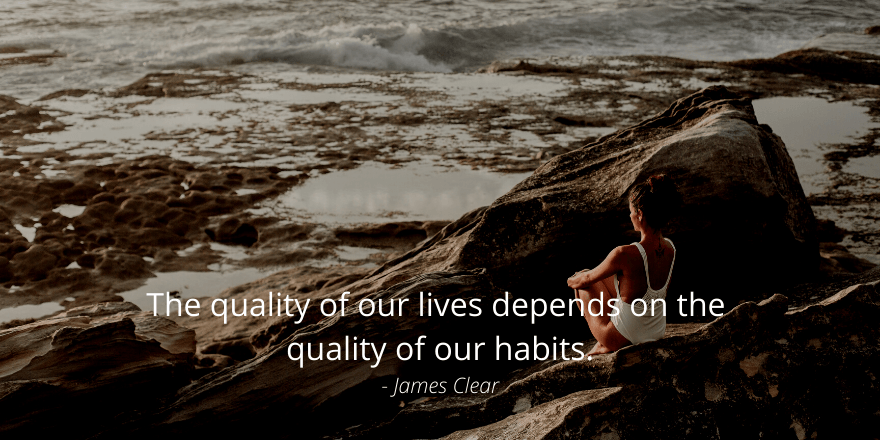
A habit is a solution-response to a problem perceived in your environment. In time, it becomes a mental shortcut learned from repeated experience. Eventually, it is repeated so often that it becomes automatic, thus, freeing up your mental capacity to focus on other tasks.
The process of building habits can be broken down into four steps known as the habit loop:
- Cue: The trigger for your brain to initiate a certain behavior.
- Craving: Motivation due to the reward you’ll get when engaging in this habit.
- Response: Enacting the behavior associated with this habit.
- Reward: The result of engaging in the habitual behavior.
If any of these four stages are lacking, it won’t become a habit. Clear then goes one step further and provides a four-step solution for creating good habits:
- Cue: Make it obvious.
- Craving: Make it attractive.
- Response: Make it easy.
- Reward: Make it satisfying.
The remainder of Atomic Habits looks at each of these steps in turn and divulges how you can create a better life thanks to cultivating better habits.
Atomic Habit Law No. 1: Make It Obvious

Your brain is a glorified prediction machine. It takes in a significant amount of data from your environment, processes it, and decides what’s important for future use. It creates patterns to predict the future based on what has gone before. In turn, this generates habitual behaviors, many of which you won’t be aware of, as they’re automatized and operate in your unconscious.
However, Clear argues that to build new habits, you need to become aware of your current habits. He suggests creating a “Habits Scorecard.” This entails listing your daily habits and assessing whether they are positive, neutral, or negative. You can start by writing down the behaviors and rituals you perform as part of your morning routine. Then, go through each of these behaviors in turn and ask whether these habits are good (e.g., effective), bad (e.g., ineffective), or neutral. This will help you become more aware of what type of habits you are cultivating every day.
The Best Way to Start a New Habit

The two biggest drivers of creating a new habit are to identify a time and a location for when and where you want the habit to take place. For example, this could mean setting a time and a route each day to do a short run. If you make a specific plan for when and where you will engage in this new habit, you are significantly more likely to follow through with it.
Another excellent way to start a new habit is to attach it to an existing habit. Clear calls this method “habit stacking.” Say, for instance, that you drink a cup of coffee at the same time every morning. If you want to start making daily meditation a habit, you could decide that after you pour your cup of coffee, you sit down to meditate for one minute. In doing so, you’ve stacked these two habits and increased the likelihood of your sticking with the new habit.
Motivation Is Overrated – Environment Often Matters More
Our environment significantly impacts our behavior. Every habit we enact is triggered by a cue, and we are more likely to be aware of cues that stand out to us. Consequently, cues that are well-hidden, e.g., the guitar that you want to practice that is in the closet, are less likely to encourage your desired habitual behavior. Therefore, if you want to make a habit that sticks, arrange your environment to include an obvious cue for it.
Atomic Habit Law No. 2: Make It Attractive

The more attractive an opportunity, the more likely you’ll use it as a springboard to create a new habit. What’s more, the greater the dopamine hit attached to the behavior, the greater your drive to perform it. This is known as the dopamine-driven feedback loop. Dopamine is a chemical in the brain that is responsible for motivation, learning, memory, punishment and aversion, and voluntary movement.
With regard to habits, dopamine isn’t only released when you experience the pleasure of the action but also in anticipation of it. For example, gambling addicts get a spike of dopamine before they place a bet, and cocaine addicts get a hit of dopamine just by looking at the powder. When dopamine levels rise, so does your drive to act, hence why the gambler then places a bet, and the addict then takes the cocaine.
An excellent way to hack this phenomenon and to create better habits is to implement what Clear refers to as “temptation bundling.” This means combining something you enjoy doing with something that you need to do but aren’t excited about. When pairing this with the habit stacking technique, the introduction of new habits into your routine could look something like this:
- After “current habit,” I will “habit I need” (e.g., the new habit you want to introduce).
- After “habit I need,” I will “habit I want” (e.g., a habit that you find particularly enjoyable).
By telling your mind that by doing the action you need to do, you get to do the thing you want, you reinforce this habit and make it more likely to stick.
The Role of Family and Friends in Shaping Your Habits
We often pick up the habits of those around us. Our friends and family create an invisible wall of peer pressure that pulls us in their direction. This can have both positive and negative consequences, dependent on your environment. Thus, one of the best things you can do to create better habits is to join a culture where your desired behavior is the norm.
Atomic Habit Law No. 3: Make It Easy
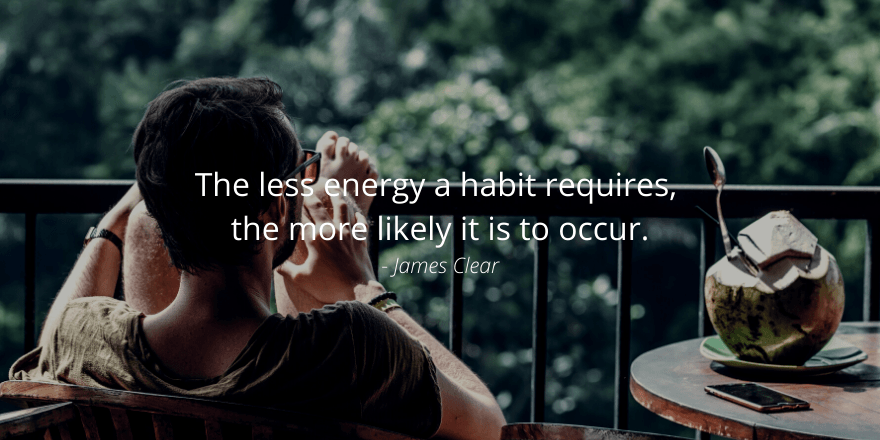
It’s often easy to put off instigating a new habit due to procrastination. Trying to work out the best way to lose weight or learn chess eats into valuable time that could otherwise be spent putting something into action. Consequently, Clear argues that it’s only actions that result in outcomes. The key to mastering a habit isn’t perfection; it’s repetition. Each time you repeat an action, you alter the structure of your brain so that it becomes more efficient at performing that activity.
Habits, therefore, are formed based on frequency. While most people ask how long it takes to build a new habit, Clear states that the real question should be how many repetitions of an action it takes to cultivate an automatic habit.
The Law of Least Effort
The brain is hardwired to follow the path of least resistance. This means that given two choices, it will opt for the easier of the two. To successfully introduce new habits into your routines, you must learn to use this to your advantage. By removing points of friction that could make keeping to your new habits challenging, you are able to achieve more with less effort.
How to Stop Procrastinating by Using the Two-Minute Rule
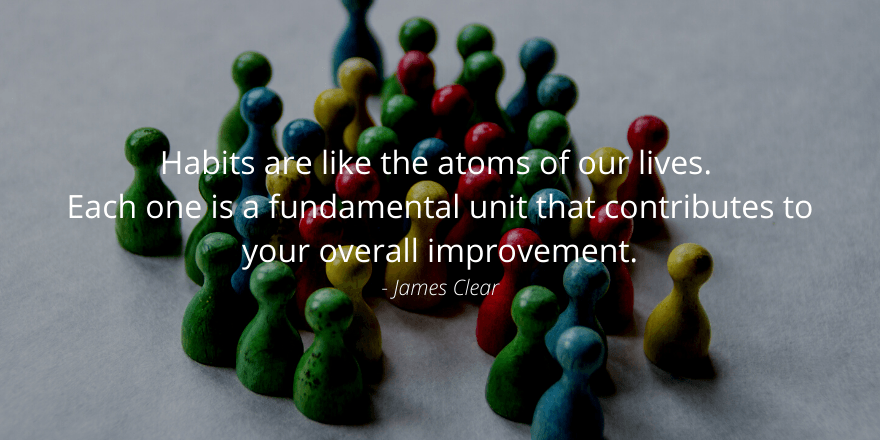
When starting a new habit, it’s easy to get over enthusiastic and to do too much too soon. Therefore, it’s not long before you burnout and give up. What’s the best way to overcome this frustrating phenomenon? What Clear calls the “Two-Minute Rule.” This means that when starting a new habit, it should take you no longer than two minutes to complete.
After this habit becomes part of your regular routine, you’ll find it much easier to increase the amount of time spent cultivating it. By merely showing up for that habit, you allow it to gradually and permanently become a part of your life.
How to Make Good Habits Inevitable and Bad Habits Impossible
To make your bad habits difficult to enforce, Clear suggests using what psychologists refer to as a “commitment device.” A commitment device is a choice you make in the present moment that dictates your future behavior. This could mean that, to avoid overeating, you purchase food in individual packages rather than in mass, or you ask to be put on the banned list of online poker sites. Both actions prevent your future self from indulging in bad habits.
Atomic Habit Law No. 4: Make It Satisfying
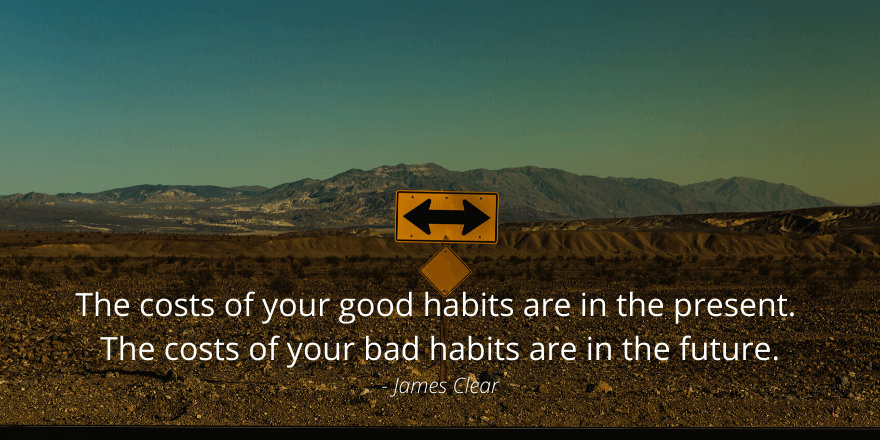
The human brain is wired to react to an immediate-return environment. Prehistoric humans had to react to environmental stimuli quickly, and they were rewarded immediately for doing so. This meant that the distant future wasn’t of great concern. Consequently, as a result of our wiring, bad habits are easy to fall into. The rewards are immediate, and the consequences are delayed (i.e., smoking or overeating). With good habits, the reverse is true. Saving money for a pension means losing money now to enjoy in the distant future, and going to the gym won’t result in any visible physical changes for many months. This can be a hurdle to implementing and sticking with good habits.
However, Clear states that you can use this knowledge to your advantage. As we repeat actions that are immediately rewarded, to get your habit to stick, you need to feel successful after completing it. By finding ways of rewarding yourself after completing a habit, you reinforce it and increase the likelihood that you will repeat it.
A useful way of reinforcing such behavior is to use a habit tracker. Here, you get a visual reward, as every time you complete a habit, you log it in to the app. Over time, you are rewarded by being able to see your progress, and this encourages you to stick with it.



Advanced Tactics: How to Go From Being Merely Good to Being Truly Great
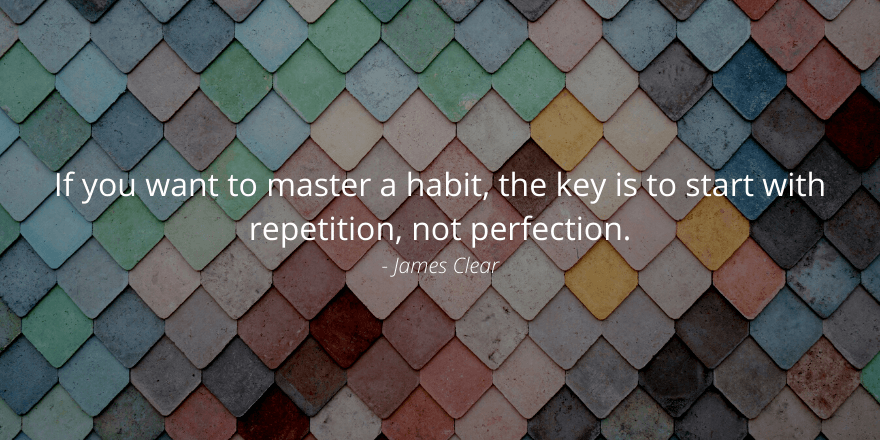
The secret to success is to choose the right field of competition to match who you are. When habits are synchronized with your natural abilities and inclinations, it makes them easier to stick with. The key is to choose habits that best suit you, not that seem to be the most popular.
A great way to work out if a habit is a good match for you is to engage in what Clear refers to as the “explore/exploit trade off.” The goal is to try many possibilities during an initial period of exploration before shifting your focus to the behavior that pairs the best with your personality. However, even when you’ve found something that works, always attribute about ten percent of your time to exploring possible new habits to prevent yourself from stagnating.
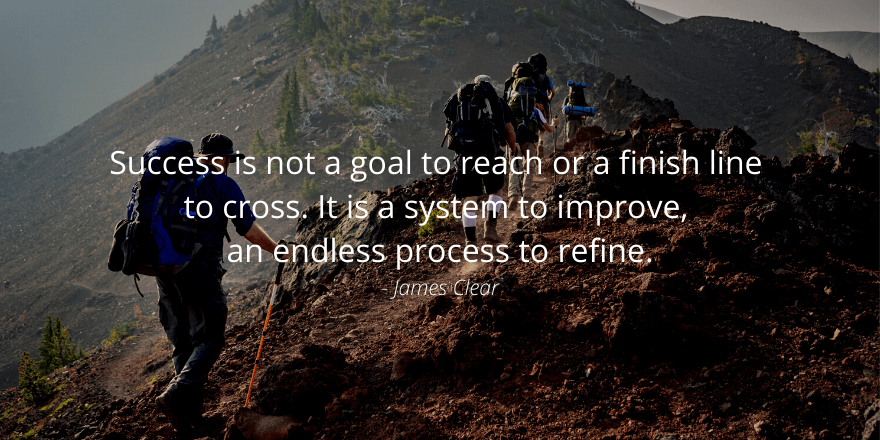
It’s also essential to review and make adjustments to your habits regularly. This prevents you from falling into a performance plateau once a habit becomes automatic and, instead, pushes you to advance. From humble beginnings as regular atomic habits, you will gradually, perhaps over many years, find yourself becoming an expert in your chosen field. Yet, it is vital to remember that there is no finish line. Clear concludes by stating that the key to great success is to never stop making improvements, as small habits don’t just add up, they compound.
You can buy Atomic Habits by James Clear on Amazon.



